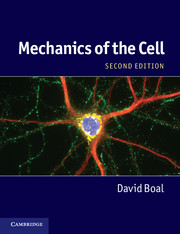Book contents
- Frontmatter
- Contents
- Preface
- List of symbols
- 1 Introduction to the cell
- 2 Soft materials and fluids
- Part I Rods and ropes
- 3 Polymers
- 4 Complex filaments
- 5 Two-dimensional networks
- 6 Three-dimensional networks
- Part II Membranes
- Part III The whole cell
- Appendix A Animal cells and tissues
- Appendix B The cell’s molecular building blocks
- Appendix C Elementary statistical mechanics
- Appendix D Elasticity
- Glossary
- References
- Index
4 - Complex filaments
Published online by Cambridge University Press: 05 June 2012
- Frontmatter
- Contents
- Preface
- List of symbols
- 1 Introduction to the cell
- 2 Soft materials and fluids
- Part I Rods and ropes
- 3 Polymers
- 4 Complex filaments
- 5 Two-dimensional networks
- 6 Three-dimensional networks
- Part II Membranes
- Part III The whole cell
- Appendix A Animal cells and tissues
- Appendix B The cell’s molecular building blocks
- Appendix C Elementary statistical mechanics
- Appendix D Elasticity
- Glossary
- References
- Index
Summary
The polymers and biofilaments described in Chapter 3 are structurally simple, such that the deformation energy of their conformations depends mainly on their resistance to bending. Consequently, the suite of shapes adopted by such filaments represents a balance between bending energy and entropy, and unless the filaments possess permanent kinks, then they are straight at low temperature. In this chapter, we consider filaments with more complex structures that arise because of their torsion resistance or because of the attraction between non-adjacent locations of the filaments. Torsion resistance can occur even in polymers because of constraints on the rotational freedom of the polymer’s backbone arising from torsion- resistant bonds or from steric constraints among side-groups to the backbone. However, in this chapter we are mainly concerned with the classic torsion resistance of thick filaments associated with shear resistance of their construction material.
This chapter begins with a descriptive overview of structures such as single and multiple helices that are observed in macromolecules and cellular filaments on length scales of one to ten nanometers. The mathematical description of helical shapes begins in Section 4.2, including the topological characteristics of twist, writhe and linking number. Then in Section 4.3, the deformation energy of a system subject to torsion is formally presented, permitting the torsional rigidity to be expressed in terms of elastic moduli such as the shear modulus and Young’s modulus. Experimental measurements of the torsional rigidity are also summarized in this section. The complex architecture of globular proteins appears in both their secondary structure (including helical segments) as well their tertiary structure (overall shape). Experimental measurements of the unfolding of protein segments with secondary structure is studied in Section 4.4, while the qualitative features of RNA folding and protein folding into tertiary structure are laid out in Section 4.5. The origin of these folded structures is the effective attraction of sections of the molecule that are not immediately adjacent to each other. To quantitatively understand what type of structures arise from such interactions, a version of the HP model (for Hydrophobic/Polar model) is studied in Section 4.6. The chapter is summarized before the end-of-chapter problems.
- Type
- Chapter
- Information
- Mechanics of the Cell , pp. 105 - 150Publisher: Cambridge University PressPrint publication year: 2012

